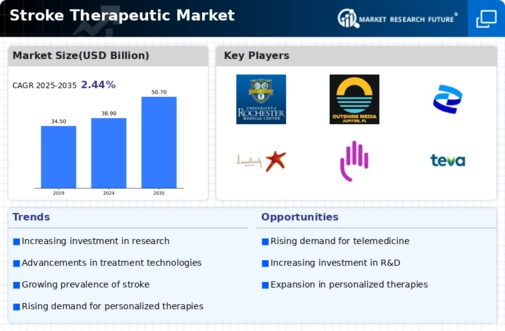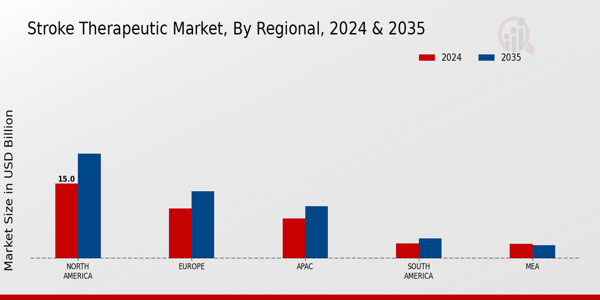Aging Population
The demographic shift towards an aging population is a critical driver of the Global Stroke Therapeutic Market Industry. Older adults are at a higher risk for stroke due to age-related health conditions and lifestyle factors. As life expectancy increases globally, the prevalence of stroke is likely to rise, necessitating effective therapeutic interventions. This demographic trend underscores the importance of developing targeted treatments for older patients. The market's growth trajectory, from 38.9 USD Billion in 2024 to an estimated 50.7 USD Billion by 2035, highlights the need for innovative solutions tailored to the unique challenges faced by the aging population.
Market Growth Projections
The Global Stroke Therapeutic Market Industry is projected to experience substantial growth over the coming years. With a market value of approximately 38.9 USD Billion in 2024, it is anticipated to reach around 50.7 USD Billion by 2035. This growth trajectory reflects a compound annual growth rate of 2.43% from 2025 to 2035, driven by various factors including technological advancements, increasing prevalence of stroke, and heightened awareness of stroke management. The market's expansion indicates a robust demand for innovative therapeutic solutions, positioning it as a critical area for investment and development in the healthcare sector.
Growing Awareness and Education
Rising awareness regarding stroke symptoms and risk factors significantly influences the Global Stroke Therapeutic Market Industry. Public health campaigns and educational initiatives aim to inform individuals about the importance of early intervention and lifestyle modifications to reduce stroke risk. Increased knowledge leads to earlier diagnosis and treatment, ultimately improving patient outcomes. This heightened awareness is expected to drive demand for therapeutic solutions, contributing to the market's projected growth. As the industry evolves, the anticipated compound annual growth rate of 2.43% from 2025 to 2035 reflects the positive impact of education on stroke management.
Increasing Prevalence of Stroke
The Global Stroke Therapeutic Market Industry is experiencing growth driven by the rising incidence of stroke worldwide. According to health statistics, stroke remains a leading cause of mortality and morbidity, with millions affected annually. The World Health Organization indicates that the global burden of stroke is expected to increase, particularly in low- and middle-income countries. This trend necessitates the development of effective therapeutic solutions, contributing to the market's expansion. In 2024, the market is valued at approximately 38.9 USD Billion, reflecting the urgent need for innovative treatments and rehabilitation strategies to address this growing health crisis.
Advancements in Medical Technology
Technological innovations play a pivotal role in shaping the Global Stroke Therapeutic Market Industry. The integration of advanced imaging techniques, such as MRI and CT scans, enhances the ability to diagnose and treat stroke patients promptly. Furthermore, the development of novel therapeutic agents and minimally invasive procedures has revolutionized stroke management. These advancements not only improve patient outcomes but also reduce healthcare costs associated with prolonged hospital stays. As the market evolves, the anticipated growth from 38.9 USD Billion in 2024 to 50.7 USD Billion by 2035 underscores the potential impact of technology on stroke therapeutics.
Regulatory Support and Funding Initiatives
Governmental support and funding initiatives significantly impact the Global Stroke Therapeutic Market Industry. Various health authorities and organizations are prioritizing stroke research and treatment development, leading to increased funding for innovative therapies. Regulatory bodies are also streamlining approval processes for new treatments, facilitating faster access to life-saving medications. This supportive environment encourages pharmaceutical companies to invest in stroke therapeutics, fostering innovation and competition. As a result, the market is poised for growth, with projections indicating a rise from 38.9 USD Billion in 2024 to 50.7 USD Billion by 2035, driven by enhanced regulatory frameworks.















